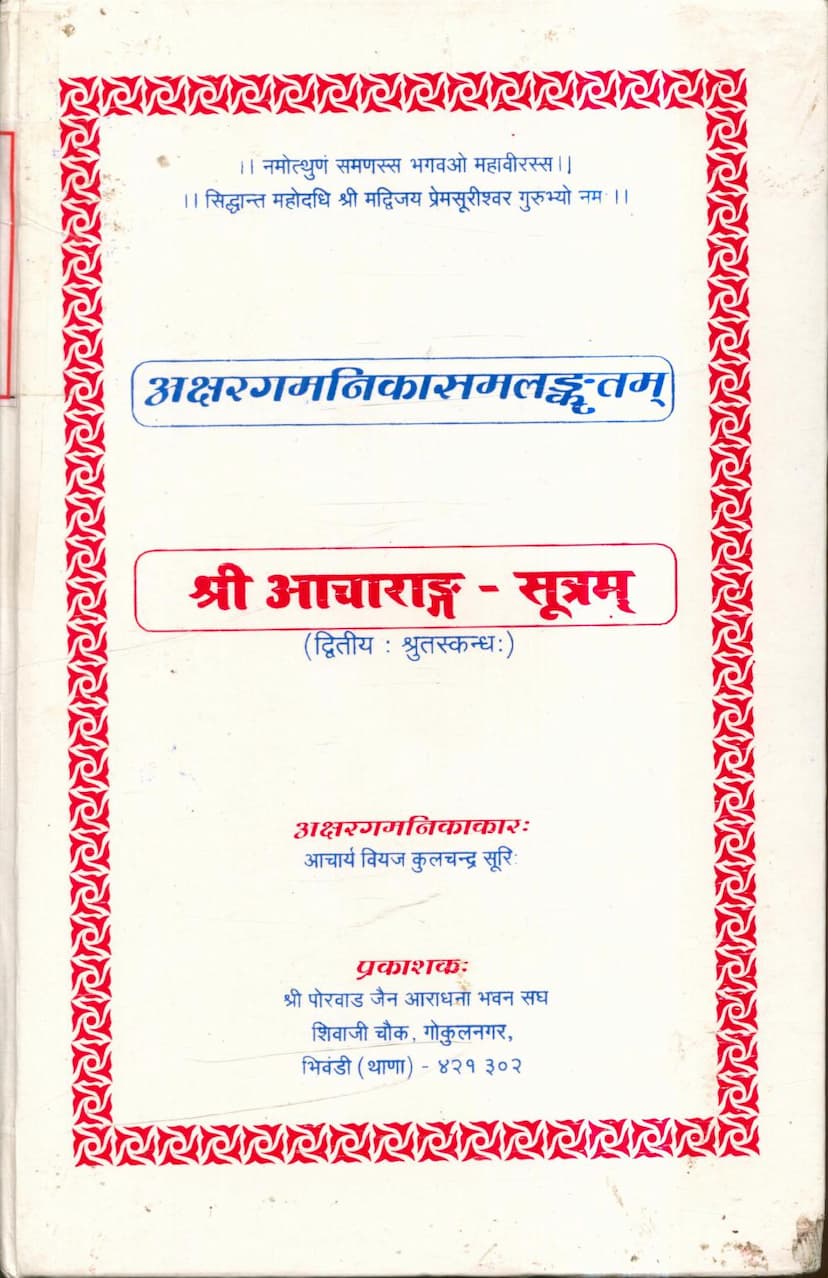Acharang Sutram Shrutskandh 02
Added to library: September 1, 2025

Summary
The provided text is the second part of the Shrutaskandha of the Acharya Sutra, a foundational text in Jainism. This specific volume, titled "Acharaanga Sutram Shrutaskandh 02," is a commentary and compilation by Acharya Vijay Kulchand Suri, published by Shree Porwad Jain Aradhana Bhavan Sangh.
The Acharaanga Sutra, particularly its second Shrutaskandha, delves into the practical aspects of a Jain monk's (Shramana) conduct and the rules governing their daily life and spiritual discipline. The commentary by Acharya Kulchand Suri aims to elucidate these principles with an "Akshara Gamanika," suggesting a detailed explanation of each letter or word.
The text is structured into several chapters (Adhyayanas) and further sub-divided into sections (Uddeshas). Based on the detailed table of contents (Vishayanukram), the second Shrutaskandha covers the following major areas:
I. Prathama Choola (First Section):
- Pindeshana (Study of Alms-seeking): This is the most extensive part, covering eleven sub-sections (Uddeshas) that meticulously detail the rules and ethics of accepting and consuming food. This includes:
- Prohibitions against accepting tainted or impure food (e.g., food mixed with life-forms, contaminated by touch, defiled by external agents).
- Rules for purifying food if it is accidentally received with imperfections.
- Guidelines for visiting households for alms, including acceptable and unacceptable places and families.
- Specific regulations regarding the type of food, its preparation, and consumption.
- Detailed discussions on what constitutes pure (Prashuka) and impure (Aprashuka) food.
- The importance of observing the purity of the alms-bowl and the food within it.
- Rules concerning the consumption of various liquids (Panaka) and their purity.
- Specific prohibitions against accepting food associated with festivals, particular occasions, or improper mixing.
- Detailed rules for monks interacting with householders and their families during alms-seeking.
- Guidelines on how to handle situations where food is offered by others or intended for others.
- The concept of "Samanya Pinda" (common alms) and how it should be handled when found.
- The importance of discretion and avoiding places or situations that might lead to impurity or spiritual compromise.
- Discussion on specific types of impurities and the monk's conduct when encountering them.
- The importance of accepting only pure and wholesome food, avoiding anything that could be considered tainted or religiously impermissible.
- Specific rules for monks when they are sick or have a physical ailment.
- Rules about the purity of the bowl and the monk's hands.
- A comprehensive explanation of seven types of alms-seeking (Sapta Pindaishana) and seven types of drink-seeking (Sapta Panaishana).
II. Dwitiya Choola (Second Section):
- This section contains seven studies (Adhyayanas), each with a single sub-section (Saptaka). It focuses on the monk's conduct in various environments and situations:
- Sthanasaptaka (Study of Places): Rules regarding acceptable and unacceptable places for monks to stay or visit, and the four types of "place-purity" (Sthanapratima).
- Nishidikasaptaka (Study of Resting/Sitting Places): Rules about suitable and unsuitable places for meditation and study, and the conduct expected there.
- Uccharaprasravanasaptaka (Study of Excretion): Guidelines on appropriate and inappropriate places for natural calls and the monk's conduct in such situations.
- Shabdasaptaka (Study of Sounds): Rules regarding listening to sounds, the monk's conduct when hearing agreeable or disagreeable sounds, and avoiding attachment or aversion.
- Roopasaptaka (Study of Forms): Rules about observing forms, avoiding attachment or aversion to beautiful or ugly sights.
- Parakriyasaptaka (Study of External Actions): Prohibitions against performing external rituals or actions performed by others.
- Anyonyakriyasaptaka (Study of Mutual Actions): Prohibitions against engaging in mutual actions or rituals.
III. Trutiya Choolika (Third Section):
- Bhavana (Mental Cultivation/Meditations): This section focuses on the mental discipline required for a monk, particularly in relation to the five great vows (Mahavratas). It explains the importance of cultivating specific mental states and attitudes to uphold these vows:
- The life story and teachings of Bhagavan Mahavir.
- The core principles of the five great vows (non-violence, truthfulness, non-stealing, celibacy, non-possession).
- Mental cultivation practices (Bhavanas) to support adherence to these vows, including managing anger, pride, deceit, and greed, and the importance of equanimity.
IV. Chaturtha Choola (Fourth Section):
- Vimukti (Liberation): This section likely deals with the ultimate goal of Jainism – liberation (Moksha) – and the path to achieving it, possibly through further contemplation on the principles discussed in the earlier sections.
The commentary by Acharya Kulchand Suri aims to make these profound and often intricate rules accessible and understandable, particularly for the monks and nuns (Sadhu-Sadhviji) in their study and practice. The preface highlights the inspiration for this publication from the teachings of their spiritual lineage. The entire work is dedicated to promoting the study and understanding of Jain scriptures.